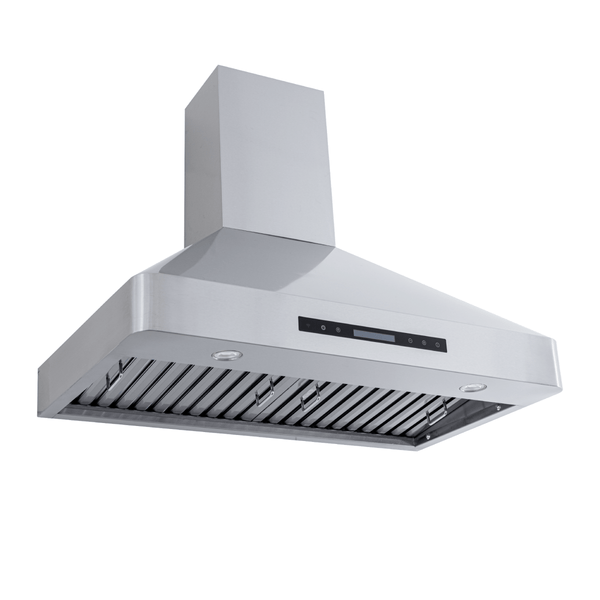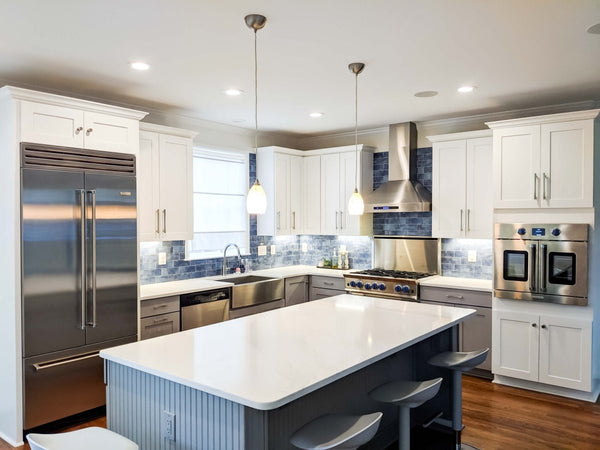To ensure your range hood has enough power:
- Gas Stoves: You'll need at least 100 CFM for every 10,000 BTUs of your stovetop. For example, a 100,000 BTU stove requires a range hood with at least 1,000 CFM.
- Electric Stoves: Multiply the stove's width (in inches) by 10. For instance, a 42" electric stove needs a range hood with at least 420 CFM.
For most kitchens, we recommend choosing a range hood with at least 600 CFM to efficiently vent cooking exhaust.
Range Hood CFM Calculator
Cooktop-Based Calculation
Step 1: Cooktop Selection
Step 2: Cooking Styles
Step 3: Ductwork Adjustments (Optional)
Kitchen Air Exchange Calculation
*Side Note: There's no one-size-fits-all when it comes to range hood CFM—it depends on your cooking habits and kitchen needs. CFM, or cubic feet per minute, measures the ventilation power of a range hood, showing how much air it exhausts at full speed. Higher CFM means stronger ventilation to keep your kitchen fresh.
The ventilation power of your range hood is measured in cubic feet per minute (CFM). CFM is how many cubic feet of air the range hood exhausts every minute at full speed. Simply put, the higher the CFM, the more air the hood vents out of your kitchen.
Explore our current range hoods on sale now! Each is tailored to elevate your kitchen's performance and aesthetics.
1. Type of Range and Output
Range hoods over electric and gas cooktops, along with outdoor grills, require different CFM ratings.
Electric Stoves
For electric stoves, multiply the stove width by 10 to find the ideal CFM. For example, a 36" stove needs a hood with at least 360 CFM.
Learn more about venting your electric stove in this article.
Gas Ranges
Gas stoves emit more heat and fumes, so higher CFM is essential. Add up the BTU output of all burners and divide by 100. For instance, a stove with 50,000 BTUs needs a hood with at least 500 CFM. When in doubt, opt for a higher CFM for gas ranges.
Learn more about venting your gas stove in our article 'Do gas ranges require venting?'
Outdoor Grills
Outdoor grills typically have higher BTUs and additional burners, so calculate their CFM the same way as gas stoves—total BTUs divided by 100.
For more details, explore our guides on venting electric stoves, gas ranges, and outdoor grills!
Check out this complete guide.
2. Size of Your Kitchen

Your kitchen's size plays a key role in determining the right CFM for your range hood. Larger kitchens need more ventilation to keep air fresh and odor-free.
How to Calculate CFM based on the size of your kitchen:
-
Find Your Kitchen's Volume: Multiply length × width × height.
- Example: 18' × 14' × 9' = 2,268 cubic feet.
-
Determine Airflow Needs: Multiply the volume by 15 (air exchanges per hour).
- Example: 2,268 × 15 = 34,020 cubic feet per hour.
-
Convert to CFM: Divide by 60 (minutes per hour).
- Example: 34,020 ÷ 60 = 567 CFM.
Or simply divide your kitchen's volume by 4.
- Example: 2,268 ÷ 4 = 567 CFM.
Final Step: Compare this CFM to the requirement for your cooktop (BTUs ÷ 100) and choose the higher number. When in doubt, opt for a hood with higher CFM since you unfortunately can't increase range hood CFM. This will create for better performance and flexibility.
3. Cooking Routines
Your kitchen habits can make or break your range hood game—so let's figure out if you need a beast of a hood to handle your culinary adventures.
- How often are you throwing down in the kitchen? Cooking every meal? Using all four burners like a pro chef? Or just boiling pasta every now and then?
- What's cookin'? Are you frying fish, grilling steak, or whipping up spicy curries? The smell test is real—stronger scents call for stronger ventilation.
- What's your vibe? Love high-heat wok tosses, greasy bacon, or steaming up the place with dumplings? Got a thing for fajitas or pizza that fills the air with smoky deliciousness?
If your kitchen is a hotspot for smoky, spicy, or greasy goodness, you'll need a higher CFM range hood to keep it fresh. Go big or go smoky.
4. Ductwork

Your ductwork plays a huge role in how well your range hood performs. If you're building a new kitchen, plan for proper ducting. But if you're working with existing ducts, size, shape, and length matter big time.
-
Duct Size 101:
Smaller ducts (4–6") suit older, low-CFM hoods. High-CFM hoods need larger ducts (8–12") to handle the airflow without resistance. Too small, and your hood can't vent properly—leaving smoke, steam, and odors behind.
-
Quick Duct Size Guide:
- 400–600 CFM = 6"–8" duct
- 700–900 CFM = 7"–10" duct
- 900–1200 CFM = 8"–12" duct
- 1200+ CFM = 10"+ duct

Remember, bigger is better—your air needs room to move!
-
Ductwork Formula for Extra CFM:
- Add 1 CFM per foot of duct
- Add 25 CFM per turn
- Add 40 CFM for a roof cap
Example: Got 12 feet of pipe, 2 turns, and a roof cap? That's an extra 102 CFM to add to your base CFM needs.
Want some real-life inspiration? Check out this article Proline Customer Kitchen Creations | Ep. 4 to see how our hoods shine in gorgeous kitchens!
How do you calculate CFM for a range hood?
Follow these steps to find the perfect range hood for your kitchen:
- Kitchen Volume: Multiply length × width × height to find your kitchen's size in cubic feet.
- Air Exchanges: Multiply the volume by 15 (standard hourly air exchanges).
- Convert to CFM: Divide by 60 (minutes per hour).
- Cooktop Power: Divide your range's total BTUs by 100.
- Compare Numbers: Use the larger number from steps 3 and 4.
-
Duct Adjustments:
- Add 1 CFM for each foot of ductwork.
- Add 25 CFM for each turn.
- Add 40 CFM if you have a roof cap.
- Final Calculation: Add the ductwork adjustments to your higher CFM number.
Example:
- Kitchen volume = 567 CFM
- Burner output = 500 CFM
- Duct adjustments = 102 CFM (12 feet of pipe + 2 turns + roof cap)
- Final CFM = 567 + 102 = 669 CFM
Choose a hood with at least 669 CFM. Make sure this fits the higher end of the recommended range for your setup.

Lastly, factor in your cooking habits. If you cook often, especially smoky, greasy, or fragrant meals, opt for higher CFM to keep your kitchen fresh and clean.
How many CFM do I need for a 36" gas range?
Take the total BTUs of your cooktop by adding up the BTUs of each burner and divide that by 100 to get the CFM. So, if your range produces a total of 60,000 BTUs, your range hood must be at least 600 CFM.
Keep in mind that other factors like length of ductwork, number of elbows, and the size of your kitchen may impact the CFM.
For example, if you have really long ductwork with three elbows (not recommended, but it can happen) you'll need much more CFM than shorter ductwork with no elbows.
In most kitchens, the above calculation will work great.
Is 400 CFM enough for my range hood?
If you used the above calculations to calculate your CFM (total BTUs of your range / 100) and came up 400 or less, then that amount of power will work great for you. But, in most cases, this won't be powerful enough to clean your kitchen air efficiently. Your range will likely produce too many BTUs for a 400 CFM hood.
You can purchase range hoods 400 CFM and under at several big box stores, but they will not match the quality of range hoods with a higher CFM rating.
We recommend high-CFM hoods to our customers because they can always use them on lower speeds. But, if you purchase a 400 CFM range hood and you realize you want 900 CFM, there's unfortunately not much you can do about that.
For more information on choosing the right CFM for your vent hood, check out our full article Is 400 CFM enough for my range hood?
Is it better to have a higher CFM?

A higher CFM is ideal because it allows you to cook a wider variety of foods compared to weaker hoods, while keeping your kitchen air clean and fresh. But it is not always your best option if you:
- Have a small kitchen where the air pulled into your hood is greater than the air coming into your kitchen
- Have a hood with small diameter ductwork that won't support a higher CFM
- Run your AC and heater often – the cool or warm indoor air will leave your home, which is your money going out the door
If your range hood lacks variable speeds, you will have no choice but to run it at a higher cubic feet per minute than you might need when you're cooking less intensively.
This means you will be removing more air from your kitchen than is necessary, potentially causing you to lose the heat you want in your home. You'll also lose the money it costs to run the hood at its max speed.
If your hood isn't sized properly, a higher CFM will not necessarily help you eliminate all the fumes. As mentioned above, your ductwork impacts the capacity of a high power blower to remove air. Your hood will not be able to do its job if your ductwork is too small, too long, or has too many bends.
Every situation is different, but you'll never regret buying a more powerful fan. We get calls every week from people that regret not getting enough before so they are looking for a new hood now.
Keep in mind that you won't be running it on its max speed all the time. Most Proline range hoods come with at least four fan speed options, so you can adjust the power of the kitchen exhaust fan to meet the requirements of any type of food preparation.
Do I need makeup air for my range hood?
There's a commonly held myth that you need makeup air for range hoods that are more powerful than around 300 or 400 CFM. But makeup air is not required for your range hood unless...
- Your building codes require makeup air
- You have a 1200+ CFM kitchen range hood in a small kitchen
- You use your high CFM range hood often
Makeup air brings outside air into the house, hopefully as close to the range hood as possible so your hood doesn't extract your home's air that you have paid to heat or cool out of the house. It also solves negative pressure problems with your ventilation system.
For more information on makeup air, check out our article here.
What is the minimum duct size for a range hood?
The minimum recommended duct size is 6" for 0-400 CFM range hoods. The smaller the duct size, the less CFM you need. The larger the duct size, the more CFM you need.
For more information on duct size, click here!
How many CFM do I need for my range hood? - Some Other Considerations

Range Hood Size Matters
If your hood isn't at least 6 inches wider than your range, it won't perform at its peak. Overhang and depth are key!
The further your hood extends past the edges of your gas or electric cooktop, the better – particularly if you have an island range. Be sure your hood is at least a size or two up from your stove or has three to six inches overhang. If you have an outdoor kitchen, aim for your hood to extend six to 12 inches past the cooktop.
Mounting Height = Ventilation Sweet Spot
Too high? Your hood will struggle to clear the air. Too low? It'll overheat and wear out faster. Keep that golden range of 28"–36" above the cooktop to ensure max efficiency and longevity.
Need mounting tips? Check out this ultimate guide!
Noise Level (Sones)
Hate loud fans? You've got options:
- Go bigger. Larger hoods run quieter at lower speeds.
- Choose Proline's hoods with efficient, whisper-quiet fans.
- Consider inline or remote blowers to move the noise away from your kitchen. Learn more about blower types here!
Easy-to-Clean Filters
Cooking a lot? Then you're cleaning a lot. Proline's stainless steel baffle filters are dishwasher-safe, making cleanup a breeze.
When in Doubt, Scale Up
More power means more versatility—especially for island hoods exposed to air on all sides. Wall-mounted hoods? They don't need as much CFM since the back wall helps funnel air through the vent.
At Proline, we offer top-tier hoods ranging from 600 to 2000 CFM, far surpassing the 250–400 CFM models at big box stores. Whether it's wall-mounted, island, under-cabinet, or outdoor, we've got the right hood for your setup. Your dream kitchen? It starts here. Wherever your needs fit within these considerations, Proline has 30-inch range hoods all the way to 72-inch. We have the styles and sizing you need.
Now that you've calculated the minimum requirements for your range hood's CFM, remember that, in most cases, it's a good idea to scale it up.
Scaling up is especially beneficial for island range hoods, which are exposed to your kitchen air on all sides. In contrast, a wall mount range hood is exposed to air from three sides; the back wall behind your range helps funnel the air through your hood to the outside. For this reason, wall mount range hoods don't need as much CFM to keep your air clean.
Wherever your needs fit within these considerations, Proline has the right range hood for you!
The most popular range hoods from big box stores are available at 250 CFM, 300 CFM, and 400 CFM. However, at Proline, we sell a wide variety of exhaust fans: wall mount range hoods, range hood inserts (Calculate what size you need here), island range hoods, under cabinet range hoods, and outdoor range hoods ranging from 600 CFM to 2000 CFM – the most powerful range hoods for your home on the market.
Related Articles
Is 300 CFM enough for my range hood?
Best 1200 CFM Range Hoods and Buyer's Guide
As an Amazon Associate, we earn from qualifying purchases.












